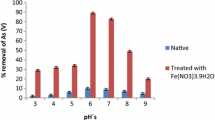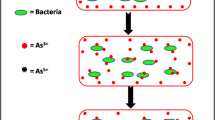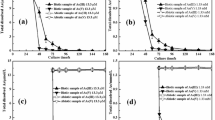Abstract
This paper evaluates heterotrophic leaching of arsenic (As) pre-adsorbed onto amorphous ferric oxyhydroxides (FeOx) and its subsequent biovolatilization under laboratory conditions during Aspergillus niger static cultivation. With initial 90 mg.L−1 As concentration and absence of FeOx, the biomass As accumulation capacity attained 1.4 mg.g−1 on the 15th day of cultivation. While FeOx suppressed As biomass accumulation up to 0.23 mg.g−1, it did not influence biovolatilization activity. After 15-day cultivation, almost 1.8 mg As was released into the surrounding culture media, accumulated and subsequently transformed into its volatile derivatives, regardless of FeOx presence or absence. The A. niger strain was able to enhance As release from the FeOx surfaces; the total As medium concentration increased to 3.1 mg.L−1 on the 15th cultivation day, and this amount was considerably higher than the 0.128 mg.L−1 As concentration leached from FeOx in fungal absence. These observations indicate that complex mutual interactions between As immobilized in FeOx and filamentous fungi are environmentally significant regarding As mobility and transformation in oxic environments.
Similar content being viewed by others
Explore related subjects
Discover the latest articles, news and stories from top researchers in related subjects.Avoid common mistakes on your manuscript.
1 Introduction
Ferric oxides, oxyhydroxides and hydrous oxides (FeOx) found in almost all soils and sediments play an important role in the arsenic (As) biogeochemical cycle (Smedley and Kinniburgh 2002). The reductive dissolution of FeOx in anoxic environments leads to adsorbed and coprecipitated As release (Nickson et al. 2000). In contrast, dissolved As in oxic environments bind strongly to the FeOx surfaces (Ghimire et al. 2003). These have high sorption capacity and are an important contaminant sink in contaminated areas (Nguyen and Itoi 2009). However, As sorption in the presence of hydroxyl, bicarbonate or phosphate anions is reduced by competition for sorption sites (Charlet et al. 2007). Besides, the contribution of microbial metabolism on adsorbed and coprecipitated As release from FeOx must be considered. Although autotrophic microorganism influence on metal(loid)s leaching from ferric and ferrous minerals is an intensively studied environmental problem (Garcia-Sanchez and Alvarez-Ayuso 2003), current literature lacks investigation of As mobilization from FeOx by filamentous fungi under aerobic conditions.
These fungi produce strongly acidic or chelating compounds such as polycarboxylic organic acids, which solubilize metal(loid)s from different oxidized ferric minerals by redox processes or pH lowering with subsequent complexation (Sayer et al. 1997). Released metal(loid)s can be subsequently accumulated and metabolized by microorganisms, with unique microbial mediated As transformation into volatile metabolites (Cullen and Reimer 1989). Various fungi, including Aspergillus niger, Aspergillus clavatus, Neosartorya fischeri, Ulocladium sp. or Penicillium sp. have been proven capable of As biovolatilization from aqueous media and solid substrates (Edvantoro et al. 2004; Urík et al. 2007). In addition, A. niger uniquely produces a high quantity of organic acids associated with significant pH decrease (Gadd 2004; Jernejc and Legiša 2004; Kubicek et al. 2011) and it easily induces mineral phases dissolution due to metabolites’ acidic or chelating properties (Hosseini et al. 2007). Since no special attention has focused on possible biotransformation of arsenic previously adsorbed onto mineral surfaces, this study evaluates heterotrophic leaching of As adsorbed onto FeOx and its subsequent accumulation and biovolatilization under laboratory conditions in static A. niger cultivation.
2 Materials and Methods
2.1 Fungal Strain
A. niger (van Tiegham) was obtained from the Mycological laboratory of the Slovak Medical University, and maintained on agar media.
2.2 Reagents and Solutions
A stock solution of arsenite [iAs(III)] (810 mg.L−1) was prepared by dissolving sodium arsenite, NaAsO2 (Merck, Germany) in deionized water. FeCl3.6H2O and NaOH used for FeOx preparation were of analytical grade (Centralchem, Slovak Republic). Arsenic standards for chemical analysis were prepared by diluting an As 1.000 g.L−1 stock solution (Merck, Germany, H3AsO4 in 0.5 mol.L−1 HNO3).
2.3 Amorphous FeOx Preparation
The FeOx sorption material was prepared by alkaline (40 g NaOH) precipitation of FeCl3 (54.06 g FeCl3.6H2O) in 1 L of deionized water under laboratory conditions. After 12-h stirring at 150 rpm, freshly prepared precipitates were filtered, washed with distilled water and dried at 80 °C. Sample X-ray amorphous characteristics were established by X-ray powder diffraction (XRD) analyses (Fig. 1) on difractometer BRUKER D8 Advance in Bragg-Brentano geometry (theta-2theta). The XRD patterns were collected using Cu Kα1 (λ Kα1 = 1.5406 Å) radiation in the 10–65 2θ range with 0.01 step size and a counting time of 1 s per step (Bačík et al. 2011).
2.4 Bioleaching Experiment
Prior to incubation, Erlenmeyer flasks (100 mL) containing 35 mL of Sabouraud dextrose broth (HiMedia, India) were inoculated with 5 mL spore suspension prepared from a 2-week-old culture. Five milliliters of iAs(III) stock solution was added to attain 90 mg iAs(III).L−1 concentration and/or the weight of 0.5 g of FeOx was added to the media. Flasked culture media without supplemented As or FeOX and non-inoculated flasks containing FeOx and iAs(III) were used as controls. All treatments were stirred for 2 h on a rotatory shaker at 150 rpm (Unimax 2010, Heidolph, Germany).
The strain was grown in stationary culture for 15 days under laboratory conditions. Fungal biomass was removed by filtration on the 2nd, 6th, 10th and 15th cultivation day, washed with deionized water and dried at 60 °C, and the biomass dry weight was recorded. The pH of each culture filtrate, including controls, was determined before further analysis. All treatments were in triplicate.
2.5 Analysis of Arsenic in Biomass and Culture Medium
Total biomass As was analyzed following microwave digestion (Multiwave 3000, Anton Paar, Austria) in 8 mL of concentrated HNO3, by hydride generation atomic absorption spectrometry (HG AAS) with the Perkin-Elmer Atomic Absorption Spectrometer model 1100 (USA) equipped with a hydride generator Labtech HG-2 (Czech Republic). Arsine was generated from sample solutions containing 1.5 mol.L−1 HCl using 1 % m/v NaBH4 in 1 % m/v NaOH as reducing agent after pre-reduction with KI (Bujdoš et al. 2000; Hagarová 2007).
Analytical procedure accuracy was tested by analyses of certified reference materials (CRM) of plants NCS DC 73349 (bush branches and leaves) and NCS DC 73350 (poplar leaves); both from the China National Analysis Centre for Iron and Steel, Beijing, China.
The residual As concentration in spent media was determined by galvanostatic dissolved chronopotentiometry on EcaFlow 150 GLP (Istran, Slovak Republic). A compact flow-through electrochemical cell type 353c with Pt auxiliary, Ag/AgCl reference and ET-Au working electrode was utilized (Istran, Slovak republic). Spent media were acidified prior to analysis with 0.1 mol.L−3 HCl and dissolved As was quantitatively oxidized by addition of 0.01 mol.L−3 KMnO4 excess (Lešková et al. 2013).
3 Results and Discussion
Total biomass As significantly increased during 15-day cultivation of the A. niger strain in initial 90 mg.L−1 iAs(III) concentration; attaining 1.4 mg.g−1 accumulation capacity (Fig. 2). In contrast, A. niger accumulation of arsenate with initial concentration of 75 mg.L−1 was only 0.055 mg.g−1 in comparison to Mukherjee and Bhattacharya (2001) experiment. This could be contributed to different arsenate and arsenite uptake mechanisms, preferentially transported by different membrane transporters (Maciaszczyk-Dziubinska et al. 2012). However, in the presence of the FeOx amorphous phase, almost all As was adsorbed onto its surface in initial cultivation stages, significantly suppressing As bioaccumulation (Fig. 2). A. niger metabolic activity then induced slow As release into the media from FeOx surfaces (Fig. 3), increasing the amount of bioavailable As to 3.13 mg.L−1 after 15-day cultivation (Fig. 4). This is considerably higher than inorganic As release triggered by natural FeOx dissolution in the absence of A. niger (Fig. 4). Here, the As average concentration in medium surrounding FeOx was less than 0.128 mg.L−1. This confirms the significant influence of filamentous fungus on As release from FeOx clearly identified in Fig. 3.
The previously mentioned leaching effect is generally mediated by extracellular products via three different mechanisms: (1) lowering the medium pH value of the medium and inducing dissolution of the substrate that binds the pollutant, (2) forming organometallic complexes which are readily dissolved in the medium and (3) competing for sorption positions on the substrate surface (Burgstaller and Schinner 1993). Here, we observed significantly low pH in the media only on the second day of cultivation (Fig. 5a). The medium pH then readily increased to its final value of 7 to 7.5. This is explained by imbalance in acidic metabolite production and its enhanced consumption in later cultivation stages, reducing acidic FeOx dissolution efficiency. It has been reported, however, that oxalate acid production is highly effective even in the 5 to 8 pH range (Ruijter et al. 1999), which correspond to media pH after the second cultivation day. Strains of A. niger are commonly applied in commercial organic acid production (Magnuson and Lasure 2004), especially for citrate and oxalate produced to maximum concentration of 200 mmol.L−1 in similarly designed experiments (Santhiya and Ting 2006). Therefore, we conclude here that the As release from FeOx is significantly enhanced by microbial organic acid production or competition of metabolites with arsenic for sorption positions on the FeOx surfaces, rather than by acidic FeOx dissolution.
Surprisingly, the amount of biovolatilized As during cultivation of A. niger is comparable in both FeOx presence and absence (Fig. 6). Therefore, it can be concluded that the limiting step for As biovolatilization is fungal metabolic capacity, rather than efficient As release from FeOx into the surrounding media (inset Fig. 6). The amount of biovolatilized As increased steadily and reached its maximum on the last day of cultivation, and the As loss from cultivation system was considerably high with average value of 1.8 mg.
Biomass increase was more significantly influenced in the presence of FeOx than iAs(III), and only a small biomass dry weight reduction was observed during cultivation in the presence of iAs(III) compared to the control (Fig. 5b). While FeOx presence slightly enhanced fungal growth on the 10th day of cultivation, it proved more toxic in early growth stages than iAs(III). Subsequent release of As from the FeOx surface into the medium was shown in biomass weight decrease (Fig. 3).
4 Conclusions
The A. niger fungal strain releases arsenite from the FeOx surface. This mechanism is most likely controlled by the production of organic chelating ligands, rather than by acidic FeOx dissolution. After 15-day fungal cultivation in the presence of FeOx with pre-adsorbed iAs(III), almost 1.8 mg As was released into the surrounding culture media, accumulated and subsequently transformed into its volatile derivatives. Our results confirm that fungal biovolatilization activity is controlled by specific biovolatilization rate of the strain itself and not by desorption of As from FeOx. This indicates the biogeochemical significance of fungi in As interaction with FeOx affected by their activity. This includes the production of exo-metabolites which induce As leaching from FeOx surfaces and As biotransformation into volatile derivatives following its uptake.
References
Bačík, P., Ozdín, D., Miglierini, M., Kardošová, P., Pentrák, M., & Haloda, J. (2011). Crystallochemical effects of heat treatment on Fe-dominant tourmalines from Dolní Bory (Czech Republic) and Vlachovo (Slovakia). Physics and Chemistry of Minerals, 38, 599–611.
Bujdoš, M., Kubová, J., & Streško, V. (2000). Problems of selenium fractionation in soils rich in organic matter. Analytica Chimica Acta, 408, 103–109.
Burgstaller, W., & Schinner, F. (1993). Leaching of metals with fungi. Journal of Biotechnology, 27, 91–116.
Charlet, L., Chakraborty, S., Appelo, C. A. J., Roman-Ross, G., Nath, B., Ansari, A. A., et al. (2007). Chemodynamics of an arsenic “hotspot” in a West Bengal aquifer: a field and reactive transport modeling study. Applied Geochemistry, 22, 1273–1292.
Cullen, W. R., & Reimer, K. J. (1989). Arsenic speciation in the environment. Chemical Reviews, 89, 713–764.
Edvantoro, B. B., Naidu, R., Megharaj, M., Merrington, G., & Singleton, I. (2004). Microbial formation of volatile arsenic in cattle dip site soils contaminated with arsenic and DDT. Applied Soil Ecology, 25, 207–217.
Gadd, G. M. (2004). Microbial influence on metal mobility and application for bioremediation. Geoderma, 122, 109–119.
Garcia-Sanchez, A., & Alvarez-Ayuso, E. (2003). Arsenic in soils and waters and its relation to geology and mining activities (Salamanca Province, Spain). Journal of Geochemical Exploration, 80, 69–79.
Ghimire, K. N., Inoue, K., Yamaguchi, H., Makino, K., & Miyajima, T. (2003). Adsorptive separation of arsenate and arsenite anions from aqueous medium by using orange waste. Water Research, 37, 4945–4953.
Hagarová, I. (2007). Speciation of arsenic in waters by AAS techniques. Chemicke Listy, 101, 768–775.
Hosseini, M. R., Pazouki, M., Ranjbar, M., & Habibian, M. (2007). Bioleaching of iron from highly contaminated Kaolin clay by Aspergillus niger. Applied Clay Science, 37, 251–257.
Jernejc, K., & Legiša, M. (2004). A drop of intracellular pH stimulates citric acid accumulation by some strains of Aspergillus niger. Journal of Biotechnology, 112, 289–297.
Kubicek, C., Punt, P., & Visser, J. (2011). Production of organic acids by filamentous fungi’. In M. Hofrichter (Ed.), Industrial applications (pp. 215–234). Berlin Heidelberg: Springer.
Lešková, A., Fargašová, A., & Molnárová, M. (2013). Phytotoxicity and bioaccumulation of arsenic in crops (Sinapis alba L., Triticum aestivum L., Hordeum vulgare L.). Fresenius Environmental Bulletin, 22, 832–838.
Maciaszczyk-Dziubinska, E., Wawrzycka, D., & Wysocki, R. (2012). Arsenic and antimony transporters in eukaryotes. International Journal of Molecular Sciences, 13, 3527–3548.
Magnuson, J. K., & Lasure, L. L. (2004). Organic acid production by filamentous fungi. In J. S. Tkacz & L. Lange (Eds.), Advances in fungal biotechnology for industry, agriculture, and medicine (pp. 307–340). New York: Springer.
Mukherjee, A. B., & Bhattacharya, P. (2001). Arsenic in groundwater in the Bengal delta plain: slow poisoning in Bangladesh. Environmental Reviews, 9, 189–220.
Nguyen, K. P., & Itoi, R. (2009). Source and release mechanism of arsenic in aquifers of the Mekong Delta, Vietnam. Journal of Contaminant Hydrology, 103, 58–69.
Nickson, R. T., McArthur, J. M., Ravenscroft, P., Burgess, W. G., & Ahmed, K. M. (2000). Mechanism of arsenic release to groundwater, Bangladesh and West Bengal. Applied Geochemistry, 15, 403–413.
Ruijter, G. J. G., Van De Vondervoort, P. J. I., & Visser, J. (1999). Oxalic acid production by Aspergillus niger: an oxalate-non-producing mutant produces citric acid at pH 5 and in the presence of manganese. Microbiology, 145, 2569–2576.
Santhiya, D., & Ting, Y.-P. (2006). Use of adapted Aspergillus niger in the bioleaching of spent refinery processing catalyst. Journal of Biotechnology, 121, 62–74.
Sayer, J. A., Kierans, M., & Gadd, G. M. (1997). Solubilisation of some naturally occurring metal-bearing minerals, limescale and lead phosphate by Aspergillus niger. FEMS Microbiology Letters, 154, 29–35.
Smedley, P. L., & Kinniburgh, D. G. (2002). A review of the source, behaviour and distribution of arsenic in natural waters. Applied Geochemistry, 17, 517–568.
Urík, M., Čerňanský, S., Ševc, J., Šimonovičová, A., & Littera, P. (2007). Biovolatilization of arsenic by different fungal strains. Water, Air, and Soil Pollution, 186, 337–342.
Acknowledgments
We thank Dr. Elena Piecková for providing Aspergillus niger fungal strain for this study. This work was financially supported by VEGA Nos. 1/0203/14 and 1/0263/15, and UK/175/2014.
Author information
Authors and Affiliations
Corresponding author
Rights and permissions
About this article
Cite this article
Urík, M., Bujdoš, M. & Milová, B. Biologically Induced Mobilization of Arsenic Adsorbed onto Amorphous Ferric Oxyhydroxides in Aqueous Solution During Fungal Cultivation. Water Air Soil Pollut 225, 2172 (2014). https://doi.org/10.1007/s11270-014-2172-x
Received:
Accepted:
Published:
DOI: https://doi.org/10.1007/s11270-014-2172-x










